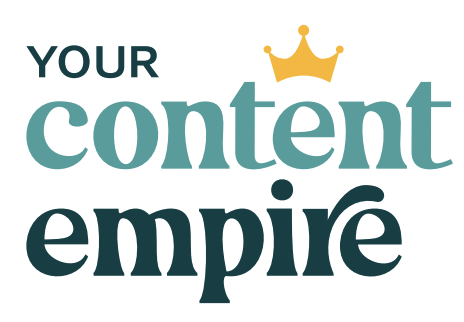Want to know the #1 reason your content isn't getting results? I see it all the time: business owners diving into content planning, color-coded editorial calendars, and posting schedules without the ONE thing (hint: it's a one page content strategy template) that could transform their scattered content into a strategic success story: a clear content strategy.
In this video, I'll show you why slowing down to speed up is the secret sauce to content that converts, and reveal the simple 5 P framework that will turn your content from random acts of marketing into a purposeful business-building machine. The best part? It all fits on a single page.
Prefer to watch this video?
Want to listen to this on the go?
Today I'm walking you through my one-page content strategy framework that will help you get crystal clear on exactly what content you should be creating, where you should be sharing it, and most importantly – WHY. This isn't about complicated spreadsheets or fancy tools. It's about getting the foundation right so everything else falls into place. Make sure to download the template in the description, grab a notebook, and let's get started!
The Difference Between Content Planning and Content Strategy
A content strategy is focused on the WHY behind your content and gives guidance on the what, who, where and how of your content plan. One of the biggest mistake I see business owners make with their content is not defining their strategy before jumping into content planning.
When you create or plan your content without a strategy – you may feel like you’re chasing different tactics and platforms without understanding exactly how they support your business goals. You may also lack clarity on your “ones”—your one person and one problem that your content is speaking to and about. You’re likely tracking metrics that don’t actually matter (or tracking nothing at all) and may be feeling underwhelmed by the results that you’re getting from content (or if you are hitting it big with your posts, videos and emails, it feels like a bit of a fluke that you stress yourself out about recreating).
You might be one of the many people who LOVE jumping to content planning and get so eager to jump to the WHAT of posting, thinking that you don’t want to waste any time. But this is one of those slow down to speed up scenarios because with the right strategy you’ll get to the right results much quicker. Another thing that may be preventing you from creating an actual content strategy to guide your editorial calendaring is a lack of clarity about what a content strategy even is.
You might be making it much more complicated than it actually needs to be. There are actually only 5 Ps that you need to remember when creating a simple (it’s just one page) content strategy that actually works while eliminating overthinking.
Section #1 of the One Page Content Strategy Template: Your Content Purpose
This is where we want to get clear on the goals of your content. Because we shouldn't start picking things like your platforms or pillars until you know what it is you want.
So what are you trying to achieve? And before you give some, duh, make more sales answer. Let's break it down even further and tie it to the journey that people typically take with your content.
Here's an example from my own business:
My main objectives with content are:
- Growing my email list (since I own my list and aren't at the mercy of social media platform changes, and it also has a predictable and relatively high ROI compared to other marketing channels)
- Drive traffic to my website (since I've seen a direct correlation between unique website views and purchases)
- And then to make sales
While making sales is my bottom line objective – I do run a business after all, and content is just a tool within that business – so there are other content goals that feed into the whole sales goal.
So what are your 3-4 overarching objectives with your content?
Section #2 of the One Page Content Strategy Template: Your ONE Person
While you can absolutely focus on serving more than one person in your business (many people do whether it's different segments or experience levels), your job will be a lot easier and your messaging much more clear if you're talking to just one person. If having more than one ideal client avatar is unavoidable, a couple of things to keep in mind:
#1 – you might want to create multiple content strategies geared towards each of those different personas.
#2 – you might have a “main” person that you mostly speak to in your content, and since no one can be a 100% match to that, there will be people outside of that narrow definition who find their way to you.
For the purposes of this strategy, I'd recommend started with your main squeeze, who is that ONE persona who 80% of your customers fit into?
We want to outline 2 things in your one-pager strategy for your ONE person.
First, write your one person statement. My audience persona is a (IDENTIFIER, i.e. busy mom of high schoolers, interior design enthusiast trying to DIY design their home, experienced business owner trying to scale to the next level in business). This statement includes 2 things – who they are (the identity they relate to) and what they're trying to do.
Second, we want to start mapping out their journey with you, your business and your content, including: before they find you, immediately after finding you, regular content consumer, first purchase, and then loyal, repeat customer. Or some version of those milestones.
Then we're going to take a quick pause, moving onto the ONE problem before revisiting our customer journey map.
Section #3 of the One Page Content Strategy Template: Your ONE Problem
Section #3 is your ONE problem (and the related problems it opens up).
If you had to sum it up – what is the one big problem that your one person is struggling with and looking to you for support with.
I'm a big believer in NOT just building a business, but finding a problem to solve and then building a business around that. I'm not sure who said the quote (actually I think it's unattributed) but one I love is “Sell the problem you solve, not the product you offer.”
Usually this overarching problem is going to be something a bit more general and wide reaching. Then you're going to get more specific about the related problems this opens up (can of worms style) for your person.
Here's an example from my own business.
My person is struggling to get consistent with their content. That's the big overarching problem. All of my content in some way, shape or form relates back to that even if I'm not overtly saying it all the time.
The specific problems this ONE problem opens up are: not seeing results with their content (whether that's sales, or audience growth or traffic), not having a working funnel or any funnel at all because it's been abandoned, not having content systems in place that make staying consistent easier. There are about a million (no joke) offshoot problems my ONE problem opens up.
So in the problem section – come up with your ONE overarching problem and 3-5 specific problems this brings up. This is where I try to get strategic though and use my ONE problem to come up with my content pillars or categories.
So back to my example – my ONE problem is “struggling to get consistent with their content” and my 3-5 specific problems (or content categories) are – lack of a working sales funnel, incomplete or overcomplicated content systems and MIA (missing in action) content strategies.
After you have your ONE problem and problematic pillars picked out, revisit your customer journey map. At each of those milestones, what are 2-3 ways this ONE is showing up for them. You can put down how they're struggling with the problem, thoughts they're having about it, what they're making it mean, emotions they're feeling and even specific words they're saying pulled from market research or interviews. This is psychographics which in my opinion are much more interesting and powerful than basic demographic information in your marketing and content.
Section #4 of the One Page Content Strategy Template: Your Platforms
Section #4 is where you'll figure out your platforms.
And you want this to be a mix of where you like to show up, but also where your ONE person actually is. There's no point cranking out content on a platform they'll rarely frequent and by doing so, you're making things a lot harder for yourself than they have to be.
Here's what to do – write down where you'll publish your long-form content, one platform where you'll engage with your audience, one platform where you'll attract an audience to your business and one platform where you'll sell.
For me – these are – YouTube (and my website), Instagram, FB ads and email.
You can put any number of platforms that you'd like, these is just an easy streamlined way to choose your platforms and get more ROI from showing up less places. If you want to learn more about this, it's called my EASE content strategy framework, and you can sign up for the free masterclass in the description.
So pick your platforms, and identify that main goals for each one plus what type of content you'll publish on these platforms. This provides that parameters that you'll use once you shift into content planning mode.
Section #5 of the One Page Content Strategy Template: Your Performance Metrics
I've maybe seen 5% of strategies in 10 years not need some pretty big tweaks after rolling them out into the real world. Which is why the performance piece is so critical. This is where we identify your top KPIs (I'm not talking tracking 100 different things) but 3 things for each goal that indicate to you, “this strategy is working.”
Revisit your purpose section and for each goal, identify 3 metrics:
The #1 lagging metric: These are the result metrics and they’re often binary (I hit it or I didn’t).
The #1 leading metric: These are basically pre-indicators of your progress towards your goals. These you have a bit more control over.
The #1 input metric: These are my actions. These are the things I do and the targets I set for my strategic actions that impact the leading metrics which then impact the lagging metrics. These are the ones I have the most control over.
Here's an example using my content strategies goals.
- For goal #1 – growing my email list, the lagging metric is my email list size or the number of people added. The leading metric is the unique views of my opt-in page. The input metric could be the amount of money I've spent on lead gen ads.
- For goal #2 – driving traffic to my website, the lagging metric is website traffic. The leading metric is number of impressions of my content in email (opens) and/or on social media. The input metric is the # of posts or email I've sent.
- For goal #3 – making sales, the lagging metric is # of sales or dollar amount of sales. The leading metric could be # unique views of salespage or # people entering my sales funnel. The input metric depends on the strategy – it could be # of sales emails I've sent, # of DM conversations, amount spend on purchase ads.
For each of these, there might be multiple options of things you could track, but limit yourself to just one thing. For input metrics specifically, ask yourself the #1 way you're actively driving results right now and decide on your input metric that way.
So what’s next after the One Page Content Strategy Template?
Want to learn how to create content that consistently converts to sales without spending hours on complicated planning?












